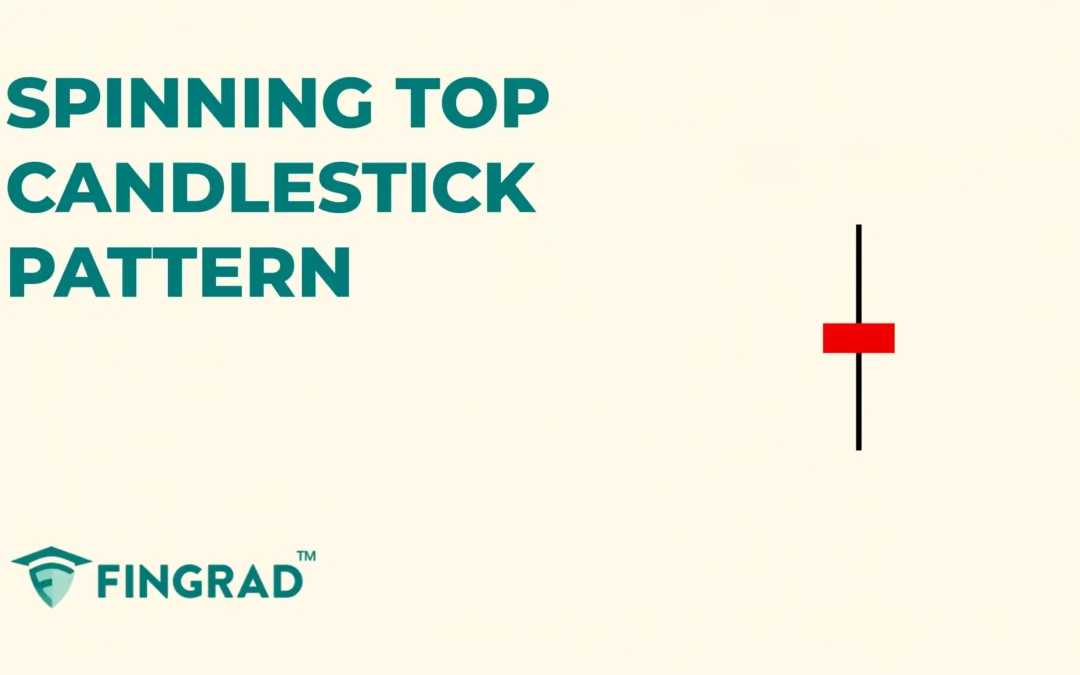When you are trading price action-based using technical analysis, you might have seen the candlesticks with a small body and long upper and lower wicks in an uncertain scenario of the price action. In the article below, we will be exploring one such candlestick pattern in detail.
In this article, we will cover the Spinning Top candlestick pattern, its structure, how to trade it with an example scenario, and the candlestick psychological pattern, along with its advantages and disadvantages.
What is the Spinning Top candlestick pattern?
The Spinning Top candlestick pattern is a single-indecision pattern, signalling uncertainty and a change in the market trend. The candlestick pattern is formed when the strength of buyers and sellers is balanced, indicating no clear trend control.
- If it is spotted at the top of an uptrend, it is also known as the Bearish Spinning Top candlestick pattern, and it signals a potential bearish reversal.
- If it is spotted at the bottom of a downtrend, it is also known as the Bullish Spinning Top candlestick pattern, and it signals a potential bullish reversal.
- If it is spotted in a sideways market, it signals ongoing indecision or low momentum.
Structure:
The Spinning Top can be spotted at the top or bottom of the trend, and the candlestick formed can be red or green.
- A Spinning Top candlestick has a small body, indicating that the opening and closing prices for the period are nearly identical.
- The upper and lower shadow/wick is at least twice the length of the body.
Psychology Behind the Spinning Top Candlestick Pattern:
- In an uptrend, the buyers dominate and push the price up to its higher high, and then sellers step in to push the price down. At the same time, buyers also defend the price levels and create a balance of pressure, and the price closes close to where it opened with the long upper and lower wicks.
- In a downtrend, the sellers dominate and push the price down to lower lows, and then buyers step in to push the price up. At the same time, sellers also defend the price levels and create a balance of pressure, and the price closes close to where it opened with the long upper and lower wicks.
- Rejection of the high and low points: The upper and lower shadows are formed. This displays the attempt of both buyers and sellers to control the ongoing trend, but neither side took over full control in that candlestick.
- Indecision Closing: In the end, the price closes near its opening, indicating indecision price action in the security.
How to trade a Spinning Top candlestick pattern?
The Spinning Top candlestick is versatile across all the frames. In the lower timeframe, it is often spotted, making it hard to identify the optimal entry and exit points.
The next candlestick after the Spinning Top candlestick is a strong directional candle (bullish if anticipating an uptrend, bearish if a downtrend)
Buy Signal:
Entry:
- As the next candle closes above the high of the Spinning Top candle, with a strong bullish candlestick, enter a long position for an upward direction.
Stop-loss:
- The stop-loss for the trade is the low of the Spinning Top candlestick.
Target:
- An ideal target is the next resistance line, or, based on your risk-reward ratio of 1:1 or 1:2.
- In the price chart, if you spot any candlestick pattern formed signalling a bearish reversal after the Spinning Top candlestick or any other bearish pattern, you can book partial profits or trail the stop-loss.
Example:
When you look at the image below, the chart of “RIL Ltd” stock at a 1-hour timeframe on 1st January 2025, you can spot the Spinning Top candlestick followed by the bullish candlestick to confirm the bullish reversal.
Sell Signal:
Entry:
- As the next candle after the Spinning Top candle closes below its low, with a strong bearish candlestick, enter a short position for a downward direction.
Stop-loss:
- The stop-loss for the trade is the high of the Spinning Top candlestick.
Target:
- An ideal target is the next support line, or based on your risk-reward ratio of 1:1 or 1:2.
- In the price chart, if you spot any candlestick pattern formed signalling a bullish reversal after the Spinning Top candlestick or any other bullish pattern, you can book partial profits or trail the stop-loss.
Example:
When you look at the image below, the chart of “RIL Ltd” stock at a 1-hour timeframe on 5th February 2025, you can spot the Spinning Top candlestick followed by the bearish candlestick to confirm the bearish reversal.
The advantages of the Spinning Top candlestick pattern?
- The Spinning Top pattern displays a non-biased signal, helping traders think clearly and wait for confirmation before making a trade.
- The Spinning Top pattern is easy to identify and trade.
- After a Spinning Top candlestick is formed, the following candlestick gives a clear understanding of the direction
The disadvantages of the Spinning Top Candlestick?
- The spinning top pattern is often spotted, making it hard to identify the potential upcoming trends in a sideways market due to a lack of volume.
- The change in the direction of the trend is dependent on the following candlesticks formed after the spinning top candlestick.
- The Spinning Top pattern provides the trend direction or strength, as it is a neutral candlestick.
In Closing
In this article, we discussed the Spinning Top candlestick pattern, its structure, the psychology of the pattern, how to trade it, along with an example of the trade, and its advantages and disadvantages.
The Spinning Top candlestick is a powerful single-candlestick pattern that leads and lags the price action according to the trading strategy, and it offers multiple opportunities for beginners with clear entry and exit signals. Making it an accessible pattern.
Your profitability depends on your approach to the trade, your risk management, and your mindset when you are holding the trade, as no indicator or tool is 100% accurate, and the Spinning Top pattern is combined with additional indicators or tools (RSI, MACD, or others), its efficiency and accuracy increase rapidly.


